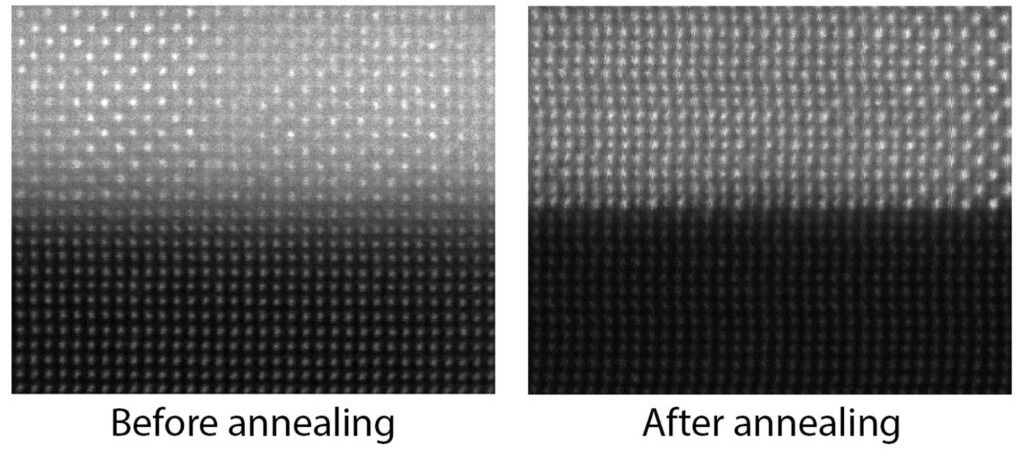Breaking records for high-temperature stability, a new nanophotonic material could lead to more effective power generation and a host of novel opportunities for the management and conversion of thermal radiation.

Microscopy images show no discernible degradation before and after heat treating the material. Image Credit: Andrej Lenert
The material, which is robust at temperatures of 2,000 ℉ in air and was created by a team of chemical and materials science engineers led by the University of Michigan, represents a roughly two-fold advance over current methods.
Shorter wavelengths can pass through the material while infrared light is reflected using a process known as destructive interference. By reflecting infrared waves back into the system, this could significantly minimize heat waste in thermophotovoltaic cells, which turn heat into electricity but cannot utilize infrared energy.
Other applications for the material include optical photovoltaics, thermal imaging, environmental barrier coatings, sensing, and concealing from infrared surveillance equipment.
It is similar to the way butterfly wings use wave interference to get their color. Butterfly wings are made up of colorless materials, but those materials are structured and patterned in a way that absorbs some wavelengths of white light but reflects others, producing the appearance of color.
Andrej Lenert, Study Co-Corresponding Author and Assistant Professor, Chemical Engineering, University of Michigan
Lenert added, “This material does something similar with infrared energy. The challenging part has been preventing breakdown of that color-producing structure under high heat.”
The method represents a significant divergence from the current state of manufactured thermal emitters, which normally use ceramics and foams to control infrared emissions.
Although they can withstand high temperatures, these materials have very little control over the wavelengths that they let through. Although previous attempts have not proven stable at high temperatures, frequently melting or oxidizing (the process that forms rust on iron) nanophotonics could provide far greater control. Furthermore, many nanophotonic materials can only remain stable in a vacuum.
By surpassing the previous mark for heat resistance among air-stable photonic crystals by more than 900 ℉ in the open air, the new material contributes to the solution of that issue. The material is also adjustable, allowing scientists to modify its energy for a wide range of potential applications.
According to the study team, adding this material to current TPVs will boost efficiency by 10%, and they anticipate that future tuning would enable considerably higher gains in efficiency.
Combining their knowledge of chemical engineering and materials science, the team created the solution. The first step taken by Lenert’s chemical engineering team was to identify substances that would not mix even if they started to melt.
“The goal is to find materials that will maintain nice, crisp layers that reflect light in the way we want, even when things get very hot. So, we looked for materials with very different crystal structures, because they tend not to want to mix,” further stated Lenert.
They postulated that a mixture of rock salt and the mineral perovskite, which is composed of calcium and titanium oxides, would work. Researchers from the Universities of Michigan and Virginia conducted supercomputer simulations to verify the combination’s viability.
The material was then meticulously deposited using pulsed laser deposition to produce precise layers with smooth interfaces by John Heron, Co-Corresponding Author of the study and Assistant Professor of Materials Science and Engineering at U-M, and Matthew Webb, a Doctoral student in Materials Science and Engineering.
Instead of using standard photonic materials, they chose oxides because they can be layered more accurately and are less prone to breakdown in high heat. This made the material much more durable.
In previous work, traditional materials oxidized under high heat, losing their orderly layered structure. But when you start out with oxides, that degradation has essentially already taken place. That produces increased stability in the final layered structure.
John Heron, Study Co-Corresponding Author and Assistant Professor, Materials Science and Engineering, University of Michigan
Sean McSherry, the Study’s First Author and a Doctoral student in Materials Science and Engineering at the University of Michigan, used computer modeling to find hundreds of other combinations of materials that are also likely to work after testing demonstrated that the material performed as intended.
The key discovery opens up a new path of inquiry into many other nanophotonic materials, which could aid future researchers in developing a range of new materials for a plethora of purposes, even if the commercial implementation of the material examined in the study is probably years away.
Defense Advanced Research Projects Agency, grant number HR00112190005, provided funding for the study.
Journal Reference
McSherry, S., et al. (2022) Nanophotonic control of thermal emission under extreme temperatures in air. Nature Nanotechnology. doi:10.1038/s41565-022-01205-1